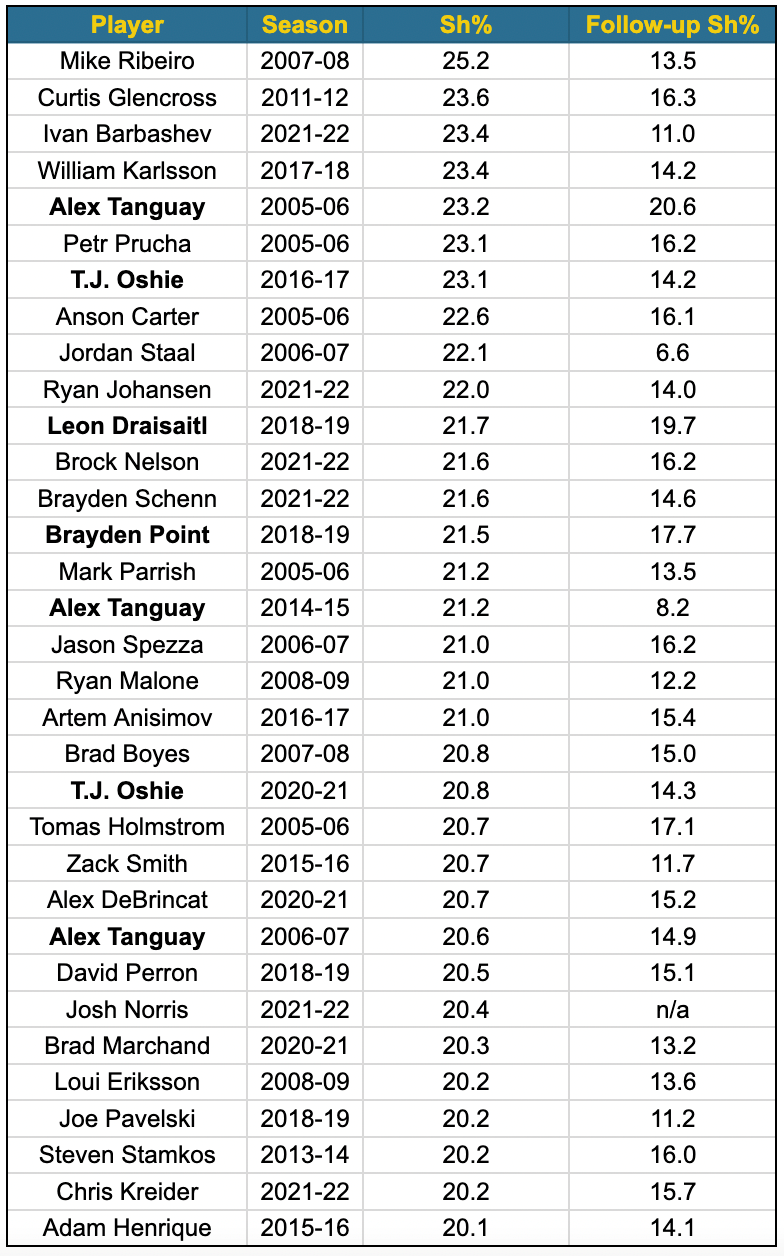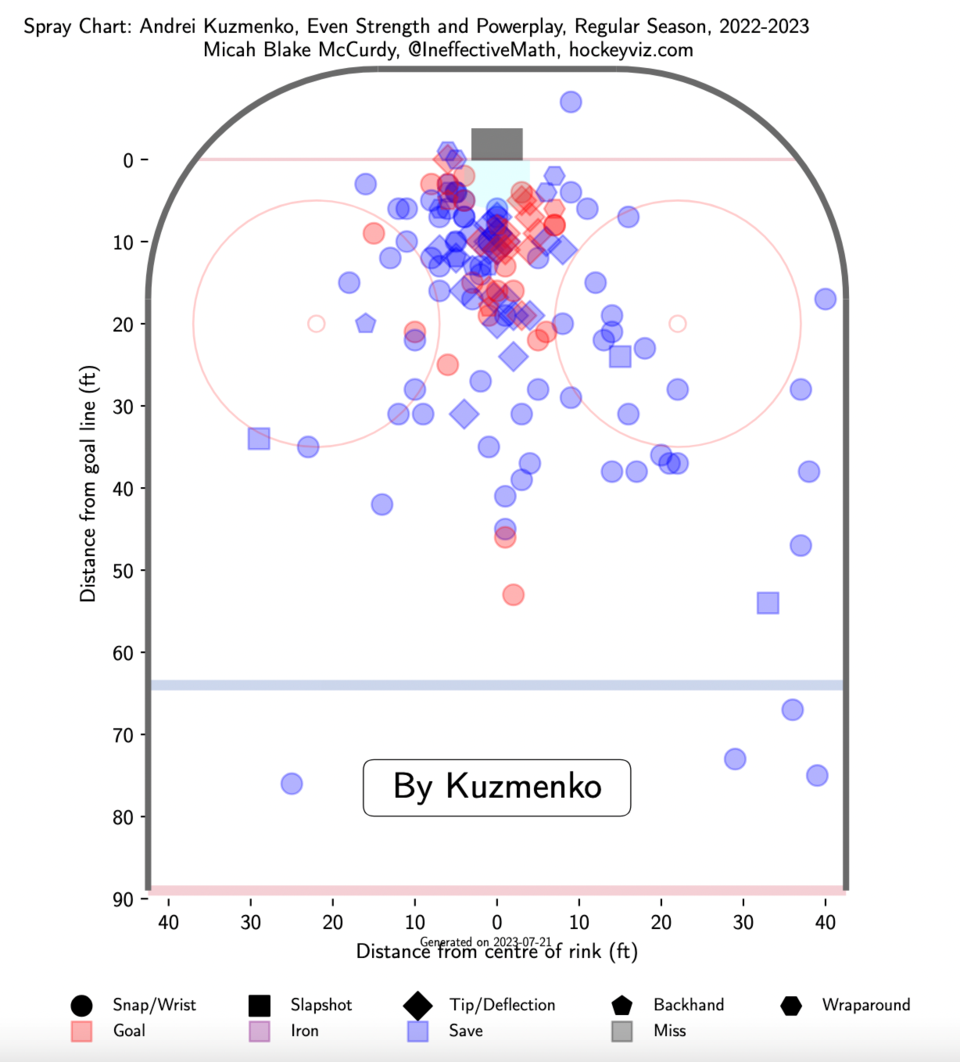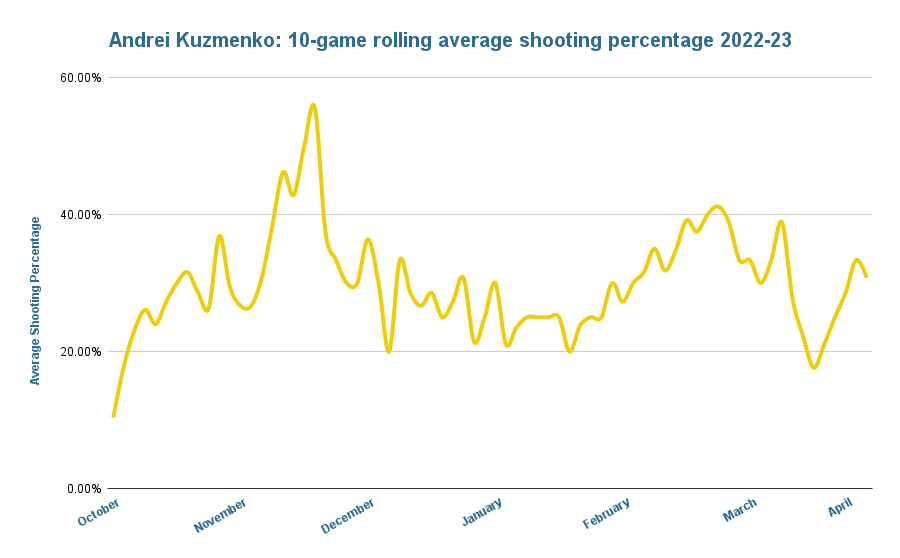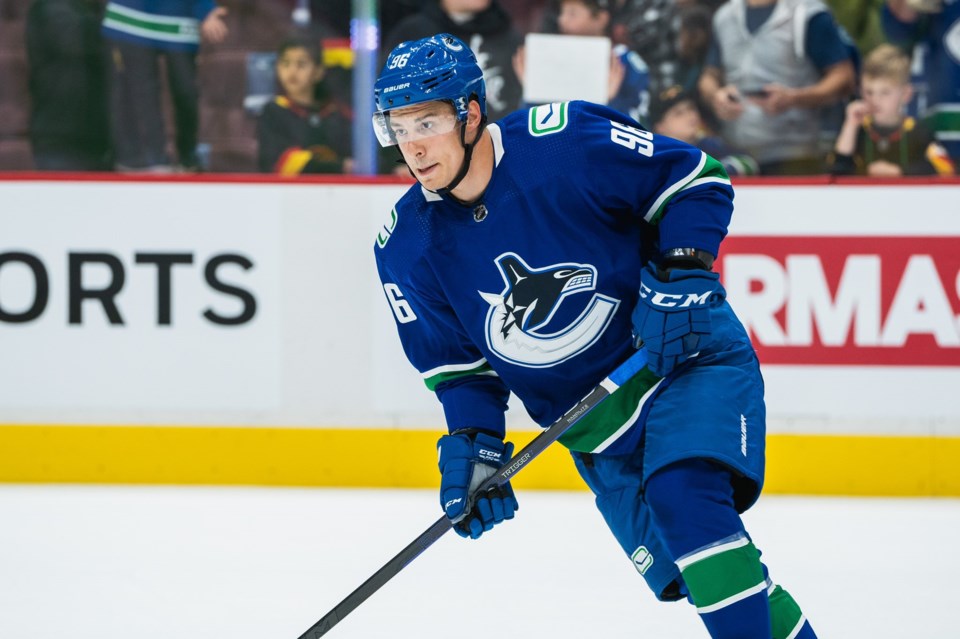Andrei Kuzmenko’s first season in the NHL went better than anyone could have predicted. The Russian winger immediately found chemistry with franchise forward Elias Pettersson, as well as a spot on the first power play unit, and racked up 39 goals.
That 39-goal season comes with one major caveat: the highest shooting percentage any player has recorded since the eighties.
Kuzmenko’s 27.3% shooting percentage is the highest for any NHL player with at least 100 shots in a season since Rob Brown scored 49 goals on 169 shots — a 29.0% shooting percentage — in the 1988-89 season when he had Mario Lemieux feeding him the puck.
In fact, Kuzmenko’s shooting percentage is the seventh-highest in NHL history since the NHL first started recording the statistic in the 1959-60 season.
Even this past season, which had the highest goal-scoring rate in the NHL since the 1993-94 season, only six players had a shooting percentage higher than 20% while taking at least 100 shots. The closest behind Kuzmenko’s 27.3% was Brayden Point at 21.7% — a 5.6 percentage point difference.
That’s patently absurd and it raises the question: can Kuzmenko possibly do it again?
Of course not.
NHL players never repeat high shooting percentages
The odds against Kuzmenko repeating his absurdly high shooting percentage are more stacked than the lady The Commodores were singing about in “Brick House.” His chances are slimmer than a dime that’s been run over by a train. He has a better probability of getting struck by lightning twice on the same day he wins the lottery.
Here are all the players since the 2004-05 lockout who recorded a shooting percentage above 20% with at least 100 shots on goal prior to this past season. In those 16 seasons, just 30 players had a shooting percentage above 20%, with two players managing to do it more than once, Alex Tanguay and T.J. Oshie.

I also bolded Leon Draisaitl and Brayden Point, who shot above 20% this season.
The average shooting percentage for those 30 players in the following season was 14.5%. That’s still above average for forwards, but much closer to average than those exceptional seasons. Notably, not one of them had a higher shooting percentage the following season after cracking 20%.
The biggest dropoff belongs to Jordan Staal, who went from a 22.1% shooting percentage in his rookie year to a 6.6% in his second year — a major sophomore slump.
Just one player managed to once again record a shooting percentage above 20% the next season — Alex Tanguay — but he didn’t have the smallest dropoff. That belongs to Draisaitl, who went from a 21.7% in 2018-19 to a 19.7% in 2019-20. He seems like the inheritor of the shooting percentage crown from Tanguay but is a much more prolific goal-scorer.
But even Tanguay and Draisaitl never reached the heights of Kuzmenko’s 27.3% shooting percentage and their career shooting percentages are 18.6% and 18.1%, respectively. Even if Kuzmenko is the type of player who maintains a very high shooting percentage, it’s likely that he regresses towards that type of number.
There’s evidence from Kuzmenko’s pre-NHL career that his shooting percentage will trend towards the higher end of forwards. The season before he came to the Canucks, he had a 19.8% for SKA St. Petersburg in the KHL and he had another season at 19.7%.
But those seasons were outliers and he never came anywhere near 27.3%. His career shooting percentage in the KHL was 14.7%.
With all that in mind, it’s essentially certain that Kuzmenko’s shooting percentage will regress to the mean next season. His shooting percentage will likely regress close to the 14.7% career shooting percentage he had in the KHL or, if he’s extremely fortunate, to around the 18% maintained by the likes of Tanguay or Draisaitl.
But here’s a counterpoint: no it won’t.
It just won’t. None of that will happen.
Kuzmenko’s shooting percentage won’t regress next season. In fact, it will never regress. If anything, it’s going to regress upwards.
Don’t tell me that doesn’t make any sense.
It didn't work for those people; but it might work for Kuzmenko
If you look at the goals Kuzmenko scored, the vast majority were tap-in goals around the net. As much as those are dependent on playing with the right teammates, it takes skill to get into the right position for those tap-in goals and to have the hands to finish around the net.
If Kuzmenko keeps playing with Pettersson — and why wouldn’t he? — he’ll keep getting those chances. There’s only so much luck necessary in finishing those off.
Kuzmenko also scored on a lot of tips — 14 of his 39 goals were classified as tips according to the NHL scorekeepers, the most in the NHL. Those require a bit more luck, as there’s a lot more randomness involved in getting just the right angle. But here’s the thing about tips from a shooting percentage perspective — they’re severely undercounted.
It’s easy to miss when a player tips a shot if it results in a save. If a scorekeeper misses it in real time, they’re not going to go back and check to see if a shot was tipped — that only happens if the tip results in a goal. If more of Kuzmenko’s tips get saved next season, that might barely show up in his shooting percentage.
Another reason why Kuzmenko had such a sky-high shooting percentage is that he avoided low-percentage shots. Unlike some wingers who shoot from seemingly any angle, Kuzmenko’s shots are clustered around the net and the middle of the ice.

Those are high-percentage areas and that kind of shooting discipline is naturally going to result in a higher shooting percentage. If he doesn’t see a high chance of scoring, Kuzmenko simply doesn’t take the shot, much to the consternation of his coaches, both in the KHL and the NHL.
“My last coach in the KHL, he says to me, ‘Please shoot, you have a great shot: shoot, shoot, shoot, shoot,’” recounted Kuzmenko when I spoke to him during the season about his reluctance to put the puck on net. “It’s maybe eight years of coach saying to me, ‘Please shoot, please shoot, please shoot.’”
It’s something Kuzmenko said he was working on throughout the season, but there was little evidence of it on the ice. In the final two months of the season, Kuzmenko averaged 1.5 shots per game.
But maybe that works for Kuzmenko. Perhaps his legitimately excellent shot should be saved for special occasions. It worked last season, as his shooting percentage wasn’t fueled by a handful of hot streaks but stayed high all season long.

After a slow start — he had just one goal in his first seven games — Kuzmenko’s shooting percentage over any given 10-game sample only dipped below 20% one time. Apart from that, it stayed above 20% all season.
That suggests that maybe, just maybe, Kuzmenko can be an extreme outlier when it comes to shooting percentage.
Okay, maybe he’s not going to repeat a top-10 shooting percentage all time, but there’s a chance that he could maintain a shooting percentage above 20% next season, just like he did for almost all of last season.
All it will take is playing to his strengths around the net: finishing off tap-in goals, tipping in point shots, and, every now and then, catching a goaltender off-guard with the wicked release on his wrist shot.
Sure, Kuzmenko is unlikely to hit 40 goals without drastically increasing the number of shots he takes but maybe he’ll be able to avoid an extreme regression in his shooting percentage.




